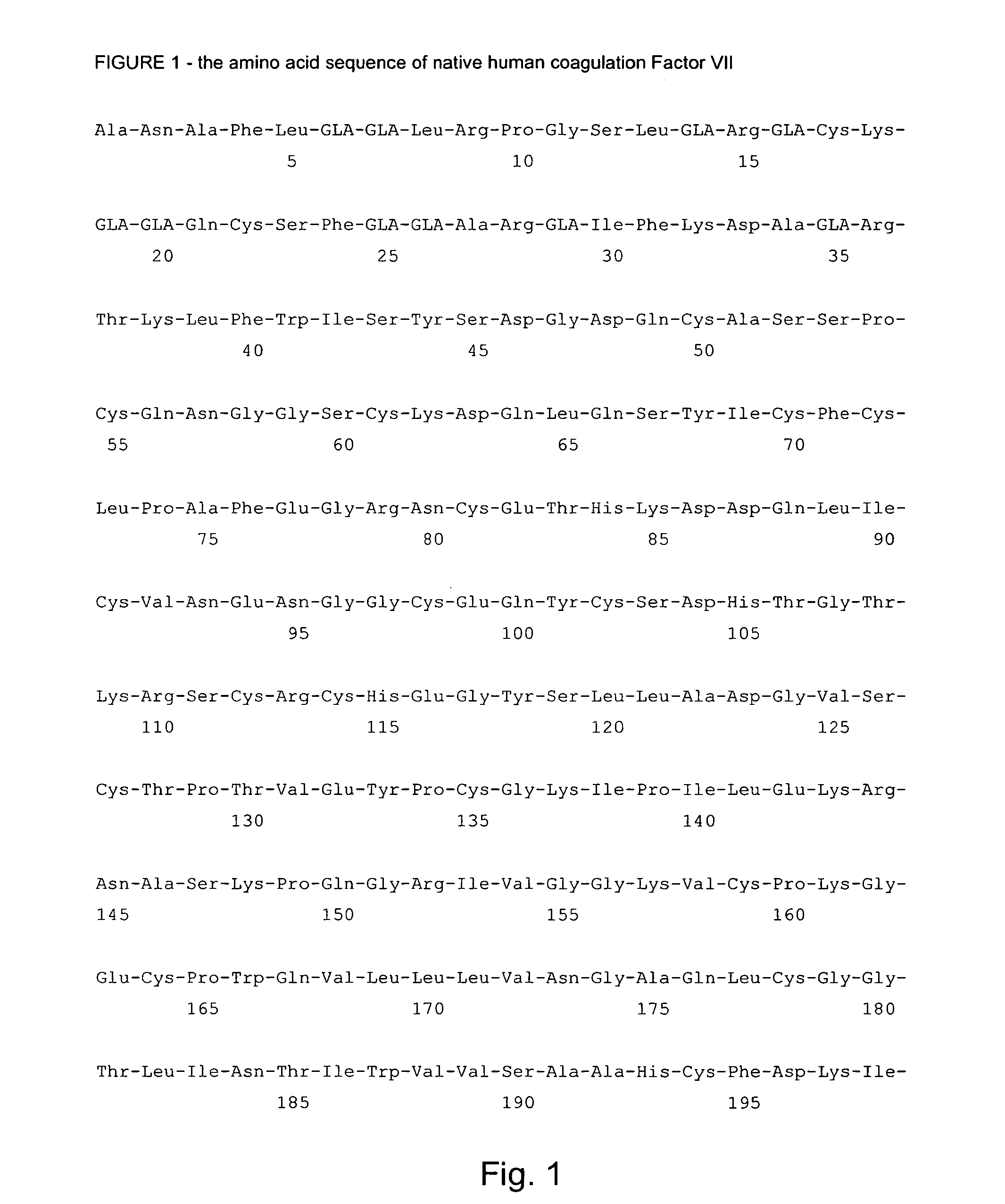Human coagulation factor VII polypeptides
a human coagulation factor and polypeptide technology, applied in the field of human coagulation factor vii polypeptides having coagulant activity, can solve the problems of fibrin clot formation and bleeding, and achieve the effect of reducing the formation of fibrin clots and reducing bleeding
- Summary
- Abstract
- Description
- Claims
- Application Information
AI Technical Summary
Benefits of technology
Problems solved by technology
Method used
Image
Examples
example 1
DNA Encoding S314E-FVII, S314E / K316H-FVII and S314E / K316Q-FVII
[0277] DNA constructs encoding S314E / K316H-FVII and S314E / K316Q-FVII were prepared by site-directed mutagenesis using a supercoiled, double stranded DNA vector with an insert of interest and two synthetic primers containing the desired mutation. The following primers were used:
(DNA primer for preparation of S314E / K316H-FVII):SEQ ID NO:25′-CTG CCT GCA GCA GGA ACG GCA CGT GGG AGA CTC CCC-3′(DNA primer for preparation of S314E / K316H FVII):-SEQ ID NO:35′-GGG GAG TCT CCC ACG TGC CGT TCC TGC TGC AGG CAG-3′(DNA primer for preparation of S314E / K316Q-FVII):SEQ ID NO:45′-CCT GCA GCA GGA ACG GCA GGT GGG AGA CTC CCC-3′(DNA primer for preparation of S314E / K316Q-FVII):SEQ ID NO:55′-GGG GAG TCT CCC ACC TGC CGT TCC TGC TGC AGG-3′(DNA primer for preparation of S314E-FVII):SEQ ID NO:65′-GCC TGC AGC AGG AAC GGA AGG TGG GAG ACT CC-3′(DNA primer for preparation of S314E-FVII):SEQ ID NO:75′-GGA GTC TCC CAC CTT CCG TTC CTG CTG CAG GC-3′
[0278...
example 2
[0280] Preparation of S314E / K316H-FVII.
[0281] BHK cells were transfected essentially as previously described (Thim et al. (1988) Biochemistry 27, 7785-7793; Persson and Nielsen (1996) FEBS Lett. 385, 241-243) to obtain expression of the variant S314E / K316H-FVII. The Factor VII variant was purified as follows:
[0282] Conditioned medium was loaded onto a 25-ml column of Q Sepharose Fast Flow (Pharmacia Biotech) after addition of 5 mM EDTA, 0.1% Triton X-100 and 10 mM Tris, adjustment of pH to 8.0 and adjustment of the conductivity to 10-11 mS / cm by adding water.
[0283] Elution of the protein was accomplished by stepping from 10 mM Tris, 50 mM NaCl, 0.1% Triton X-100, pH 8.0 to 10 mM Tris, 50 mM NaCl, 25 mM CaCl2, 0.1% Triton X-100, pH 8.0. The fractions containing S314E / K316H-FVII were pooled and applied to a 25-ml column containing monoclonal antibody F1A2 (Novo Nordisk, Bagsvaerd, Denmark) coupled to CNBr-activated Sepharose 4B (Pharmacia Biotech).
[0284] The column was equilibrated...
example 3
[0285] Preparation of S314E / K316Q-FVII.
[0286] BHK cells were transfected essentially as previously described (Thim et al. (1988) Biochemistry 27, 7785-7793; Persson and Nielsen (1996) FEBS Lett. 385, 241-243) to obtain expression of the variant S314E / K316Q-FVII. The Factor VII variant was purified as follows:
[0287] Conditioned medium was loaded onto a 25-ml column of Q Sepharose Fast Flow (Pharmacia Biotech) after addition of 5 mM EDTA, 0.1% Triton X-100 and 10 mM Tris, adjustment of pH to 8.0 and adjustment of the conductivity to 10-11 mS / cm by adding water. Elution of the protein was accomplished by stepping from 10 mM Tris, 50 mM NaCl, 0.1% Triton X-100, pH 8.0 to 10 mM Tris, 50 mM NaCl, 25 mM CaCl2, 0.1% Triton X-100, pH 8.0. The fractions containing S314E / K316Q-FVII were pooled and applied to a 25-ml column containing monoclonal antibody F1A2 (Novo Nordisk, Bagsvaerd, Denmark) coupled to CNBr-activated Sepharose 4B (Pharmacia Biotech).
[0288] The column was equilibrated with ...
PUM
| Property | Measurement | Unit |
|---|---|---|
| concentration | aaaaa | aaaaa |
| concentrations | aaaaa | aaaaa |
| weight | aaaaa | aaaaa |
Abstract
Description
Claims
Application Information
 Login to View More
Login to View More - R&D
- Intellectual Property
- Life Sciences
- Materials
- Tech Scout
- Unparalleled Data Quality
- Higher Quality Content
- 60% Fewer Hallucinations
Browse by: Latest US Patents, China's latest patents, Technical Efficacy Thesaurus, Application Domain, Technology Topic, Popular Technical Reports.
© 2025 PatSnap. All rights reserved.Legal|Privacy policy|Modern Slavery Act Transparency Statement|Sitemap|About US| Contact US: help@patsnap.com


